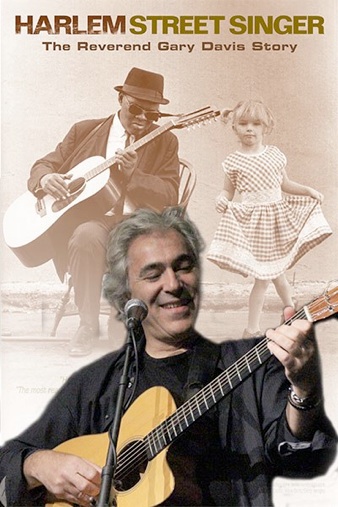There are gods of music we revere, who occupy the highest pantheon of our memories. For this author, the blind Reverend Gary Davis is one of them. Davis was an inspiring guitarist and an influence for many folk and rock legends; Dave Van Ronk, Jorma Kaukonen (Hot Tuna, Jefferson Airplane) and Bob Weir (The Grateful Dead) among them. This is also true about one former Davis student, Woody Mann — guitarist extraordinaire, teacher, and now, musical director for the just-released film about the Reverend, Harlem Street Singer.
An Education
Woody Mann was born in Queens and grew up on Long Island, N.Y. He became interested in folk guitar during the ’60s folk boom and went around asking for tips on how to play fingerstyle guitar. He got shooed away by players like Van Ronk and turned to Happy Traum’s book for instruction. Seeing Gary Davis’ name as the source for the song “Candyman,” he looked Davis up in the phone book. He called, and Davis’ wife, Annie answered. Establishing that this was indeed the correct contact for the song’s author, Woody asked if he could stop by. Intending just to visit, when he saw Gary play, he was awed and asked for lessons. Gary said “sure,” and Woody’s true musical education began. Like many others, Woody was the recipient of the Reverend’s generous spirit. For $5 per lesson, he got four to six hours of instruction and, many times, dinner. Gary would have students play a piece over and over until they had it down. At intervals, they’d jam together. Many times Woody, his fingers sore, would say, “Brother Davis, I’ve got to go.” Gary would respond, “Let’s play one more!” Woody’s repertoire embraces a number of styles. One factor in his evolution was Gary’s habit of teaching a piece differently from week to week. Woody would argue that he’d taught it differently the previous time but finally figured out that Gary was constantly improvising.
Woody’s lessons with the Reverend stretched over four years from 1968 to 1972 and overlapped his prep school days at Julliard, where he studied clarinet. Woody earned a B.A. at Empire State College in 1974 then went back to Juilliard to study music performance and composition in 1975 and 1976. He also studied improvisation with jazz pianist Lennie Tristano (who would simply point out what Woody should do and then listen as he played it on guitar).
The Film
Woody had made audio tapes of every lesson he took with Gary and wanted to make use of them — 60 hours worth — to somehow tell Gary’s story. Because Gary moved away from blues and focused more on gospel, he hasn’t been revered the way many blues artists have. Woody decided that he wanted to make a film. The genesis for Harlem Street Singer came from his business associations as founder of International Guitar Seminars (IGS). While the tapes weren’t enough to build a film around, director Trevor Laurence — who’d made instructional videos for IGS — agreed to work on a film about the Reverend. The process began in earnest when they received initial funding from executive producers Robert Davoli and Eileen McDonagh and the hunt for historical material commenced. It took six years for the film to be finished, with footage of Gary’s first appearance at Newport Folk Festival acquired just before completion.
The film covers the story of Gary’s rise from his childhood in South Carolina, to his time as an entertainer in Durham, N.C, then as a busker in New York City in the ’50s, followed by recognition and financial reward in the ’60s. Interviews with Gary were sparse, and film historians and witnesses fill in the gaps. John Cohen of the New Lost City Ramblers, also a photographer, provided many valuable pictures of the Reverend as well as commentary for the film. Pictures of Woody as a young, long-haired guitar slinger are shown. We also hear a snippet of audio from one of his lessons. Among the people who spent time with the Reverend and have stories to tell are David Bromberg, Stefan Grossman, Roy Book Binder and Happy Traum. Included are a couple of anecdotes about Gary’s fondness for firearms. The picture that emerges is of one very tough blind man. Some segments make Gary’s absence more acutely felt (He died in 1972). The fret-popping, finger-snapping and guitar body percussion on his version of “Samson and Delilah” is revelatory. The last film segment, from Newport, of Gary performing “Twelve Gates to the City,” shows the raw power of his vocals and is extremely moving.
Woody has released an elegant album of instrumental versions of songs by and about Gary, A Tribute To The Reverend. The quartet seen playing Gary’s music in the film, the Empire Roots Band, with Woody, Bill Sims, Jr., Dave Keyes and Brian Glassman, has also released an album, Music from the Film Harlem Street Singer.
The film will finish its run at the IFC Theater on Sixth Avenue in Greenwich Village on Oct. 2. It will be seen in this area again at Cinema Arts Centre in Huntington, N.Y., Oct. 22. A musical performance will follow. Woody will appear at The Minstrel Coffeehouse in Morristown, N.J., Oct. 17th. We urge readers to see Woody and the film or acquire a DVD when it becomes available.
woodymann.com | harlemstreetsinger.com


